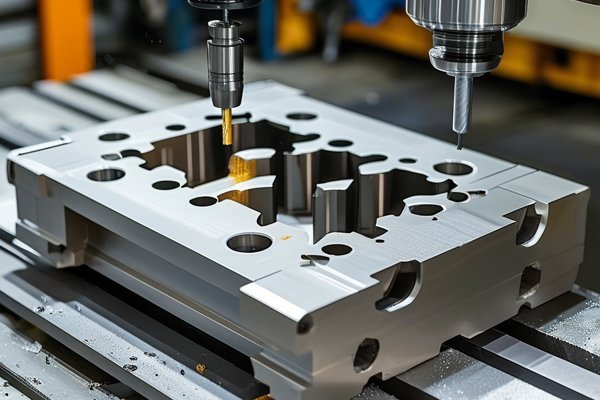Did you know that the CNC machining industry is expected to reach a staggering $100 billion by 2027? This growth is largely driven by the increased demand for precision manufacturing across various sectors such as aerospace, automotive, medical devices, and consumer electronics. With its capability to create complex geometries and tight tolerances, CNC (Computer Numerical Control) machining has become an integral solution for companies needing custom precision metal parts.
In this comprehensive blog, we will explore the numerous benefits of using CNC machining for custom precision metal parts, delve into the technology behind it, and showcase real-world applications and solutions to make the most of CNC machining in your manufacturing processes.
The Basics of CNC Machining
CNC machining involves using computer-controlled machinery to automate the manufacturing process. This technology allows for precise cuts, patterns, and modifications to be applied to various materials—primarily metals. The process is applicable across several fabrication methods such as CNC turning, milling, and grinding.
One of the foremost advantages of CNC machining is its unparalleled accuracy. Traditional machining methods require manual effort that may lead to human errors. However, CNC machines operate based on computer-coded instructions, reducing the risk of inaccuracies significantly.
Precision is especially crucial when dealing with custom parts used in critical operations, such as aerospace components and medical devices. CNC machines can achieve tolerances as tight as 0.001 inches, ensuring that parts fit perfectly without the need for excessive post-machining procedures.
While the initial investment in CNC technology can be high, the long-term cost savings make it a worthy consideration for manufacturers. CNC machining minimizes waste through its efficient use of materials, and with the ability to produce parts faster, it also reduces labor costs.
Additionally, CNC machining allows for the simultaneous manufacturing of multiple parts, which is a substantial advantage for large-scale operations or custom bulk orders. The end result is a more economical manufacturing process that generates higher profits.
CNC machining excels in its capacity for product customization. Using CAD (Computer-Aided Design) software, manufacturers can easily modify existing designs or create new ones, which can then be instantly communicated to the CNC machine for production. This level of flexibility caters to the ever-changing demands of industries such as automotive and consumer electronics, where unique and customized solutions are often necessary.
Once a CNC machine has been programmed to produce a part, it can replicate the process indefinitely with the same precision and quality. This repeatability is essential for companies that require consistent quality across numerous components.
For example, in the medical field, devices such as prosthetics or surgical instruments must be manufactured to strict standards, ensuring that every unit is identical. CNC machining’s ability to consistently produce the same result underlines its importance for industries where quality cannot be compromised.
CNC machining is not limited to just one or two types of metal. It can work with a wide array of materials, including aluminum, brass, stainless steel, copper, and even plastic. This versatility facilitates the creation of custom precision parts tailored to specific application requirements.
Manufacturers can diversify their product offerings, exploring niches that require different materials without needing to invest in entirely new machinery.
In manufacturing, time is often money. CNC machining accelerates the production cycle, allowing for faster turnarounds on projects. This efficiency is made possible due to the automation of the entire machining process—from initial coding to cutting and finishing.
Companies that leverage CNC technology can respond swiftly to client orders and market changes, positioning themselves advantageously within competitive industries.
A further benefit of CNC machining is the safety it can provide in the manufacturing environment. Traditional machining often involves manual handling of heavy equipment and hazardous machinery, which can pose risks to operators.
CNC machines, on the other hand, require minimal human interaction during operation. Most of the processes are automated and can be conducted from a safe distance, thereby reducing the likelihood of accidents.
The CNC Machining Process Explained
CNC machining involves several stages, starting from design to production. Let’s delve into the steps involved in creating custom precision metal parts through CNC machining.
Step 1: Designing the Part
The process begins with the design phase, where engineers or designers create a 3D model of the part using CAD software. This model should include every necessary measurement, specification, and tolerance.
Step 2: Generating G-Code
Once the design is finalized, the CAD model is converted to G-code, which is the language CNC machines understand. G-code contains instructions for the machine on how to create the part, detailing movements, speeds, tooling, and more.
Step 3: Tool Selection
Based on the part design and materials used, the appropriate cutting tools must be selected. The choice of tooling will impact the overall machining process and the quality of the final part.

Step 4: Machine Setup
Before production begins, the CNC machine must be properly set up. This includes securing the workpiece, installing the selected tools, and inputting the necessary G-code instructions.
Step 5: Machining
Once everything is in place, the CNC machine starts the machining process. It follows the G-code instructions precisely, performing milling, turning, or grinding to shape the metal into the desired part.
Step 6: Quality Control
Post-machining, the parts undergo rigorous quality checks to ensure they meet the required specifications. This typically involves measuring dimensions, testing tolerances, and assessing surface finishes.
Real-World Applications of CNC Machining
Aerospace Industry
The aerospace industry demands exceptionally high standards for safety and performance. CNC machining plays a critical role in producing components such as brackets, housings, and engine parts that meet stringent regulatory requirements.
Automotive Sector
In automotive manufacturing, CNC machining is valuable for creating custom parts such as engine components, exhaust systems, and intricate interior features. The ability to produce complex shapes and achieve high precision makes it ideal for both mass production and custom projects.
Medical Devices
CNC machining is instrumental in the production of precision medical devices. Whether it’s creating parts for surgical instruments or developing implants, the accuracy and repeatability of CNC machining ensure that products meet health and safety standards.
Consumer Electronics
The consumer electronics market relies heavily on well-engineered components manufactured through CNC machining. From smartphone cases to intricate circuit board housings, the technology enables rapid production of high-quality parts that appeal to tech-savvy consumers.
Automation and Robotics
Automation and robotics industries leverage CNC machining for components that require highly accurate tolerances. Parts produced using CNC technologies can be integrated into robots, allowing for improved performance and precision in automated tasks.
Challenges and Solutions in CNC Machining
While CNC machining presents numerous advantages, it does come with its own set of challenges. Understanding these challenges and how to address them is essential for manufacturers looking to maximize efficiency.
Challenge: High Initial Investment
Solution: When considering CNC machining, many manufacturers hesitate due to the high upfront costs of machines and software. To combat this, companies can start small with a single machine and progressively scale as demand grows. Renting or leasing equipment might also be viable to lessen the financial burden initial investments pose.
Challenge: Technical Skillset
Solution: Managing CNC machines requires skilled operators who understand both the machinery and programming. Companies can invest in training programs or partner with vocational institutions to ensure their workforce is adequately trained.
Challenge: Maintenance Costs
Solution: Like any machinery, CNC machines require maintenance to ensure optimal performance. Developing a structured maintenance program that includes routine checks and software updates will minimize downtime and enhance production efficiency.
Challenge: Complexity in Design Changes
Solution: Rapidly changing consumer demands can lead to frequent adjustments in designs. Utilizing advanced CAD software that allows for instant modifications and having a flexible CNC setup can mitigate these issues.
CNC machining has transformed the landscape of precision manufacturing of custom metal parts. Its ability to deliver high accuracy, cost efficiency, and repeatability makes it an essential solution for industries that require complex and customized components.
Throughout this blog, we explored the benefits, processes, applications, and challenges associated with CNC machining. By tapping into this sophisticated technology, companies can enhance production capabilities, ensure high-quality output, and remain competitive in an ever-evolving market.
As you contemplate integrating CNC machining into your operations, remember that its long-term benefits far outweigh the initial challenges. Understanding the technology and its capabilities can unlock new avenues for innovation and growth, making it a worthy investment for any manufacturer.
The success of precision engineering in your industry may very well depend on the informed choices you make regarding CNC machining practices. Keep this blog at the forefront of your thoughts as you steer towards enhanced manufacturing excellence.






